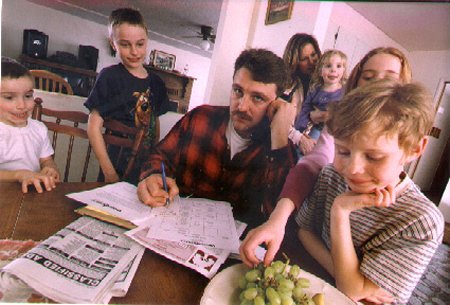
U.S. Industrial Workers Feel the Cold Grip of Recession Page 12 Joe Artle, Freightliner Truck Plant Portland, OR |
 IAM member Joe Artle, shown here with his family, is one of the 1,800 Oregon workers laid off by Freightliner since October. You hear the “R word” more and more these days. Are we headed for a recession? Did we dodge the bullet? Or is the U.S. in recession already? While politicians and pundits debate the matter, this much is clear: Economic growth has sputtered to a standstill ÐÐ and U.S. manufacturing workers are taking a terrible beating. More than 190,000 manufacturing jobs disappeared between December 2000 and March 1 alone, the U.S. Bureau of Labor Statistics reports. That 90-day total exceeds the 133,600 manufacturing jobs eliminated during all of 2000 -- an extraordinary drop. “I’m cleaning out my desk right now,” explains IAM member Joe Artle from inside the Freightliner truck plant in Portland, Oregon. “They laid off 770 IAM members last October. Now, they’re laying off another 1,085 out of a total 2,300 . . . My kids are starting to ask me, “What are you going to do?’” The plight of the Freightliner workers highlights how
badly manufacturing is being mauled: 3,670 trucking companies went belly-up
last year, along with 35,000 independent owner-operators.
Sharp cuts in business investment slashed demand for costly new technologies, clobbering the “dot com” sector. Wholesalers (the middlemen between manufacturers and buyers) took a huge hit, as well. And as consumers felt the pinch, sales plunged at high-end retailers like Nordstroms and The Gap, and even at medium-price department stores like Sears and J.C. Penney. “January set a record for layoffs É an average 6,182 a day, breaking an all-time high set just a month earlier,” the New York Post reported early this year. “The risk of recession has become acute,” warns a recent report by the Economic Policy Institute. “Business and consumer debt levels are high relative to income, and the country has accumulated a large foreign debt. A recession, if it develops, could turn nasty.” Which Way Out? Fed officials claim they have coaxed the economy to a “soft landing.” Their claim only highlights the political nature of economics: your view of a “soft” or “hard” landing depends largely on how much has landed on you. Likewise, your choice of strategies for an economic turnaround depends on who you feel should receive most of the benefits, or shoulder most of the burden. The Bush administration and Congressional Republicans are pressing for an immediate tax cut and ramming through a bill (heavily backed by big banks and credit card companies) to make it harder and more costly for working people to declare personal bankruptcy. EPI Director Jeff Faux argues that an economic recovery should be achieved through continued, lower interest rates, combined with policies that would discourage reckless investments and loans and encourage domestic production and exports. EPI also says the government should stimulate the economy by issuing each permanent U.S. resident a $500 check. EPI says its proposed “prosperity dividend” is superior to the Bush tax cut, because it would boost consumer spending four times more, have an immediate impact and favor working families instead of the super-rich. While the debate rolls on, Joe Artle is almost finished cleaning out his desk. “In 1990, I was laid off more than a year,” he recalls. “My wife was pregnant with our first child. Now, we’ve got five kids. Last time, we lost the down payment for the house. This time, we could lose the house.” “I’ve been through this before, and we’ll be OK ÐÐ for a while,” he says glumly. “But a lot of my coworkers have never been through this. My heart goes out to them.” |